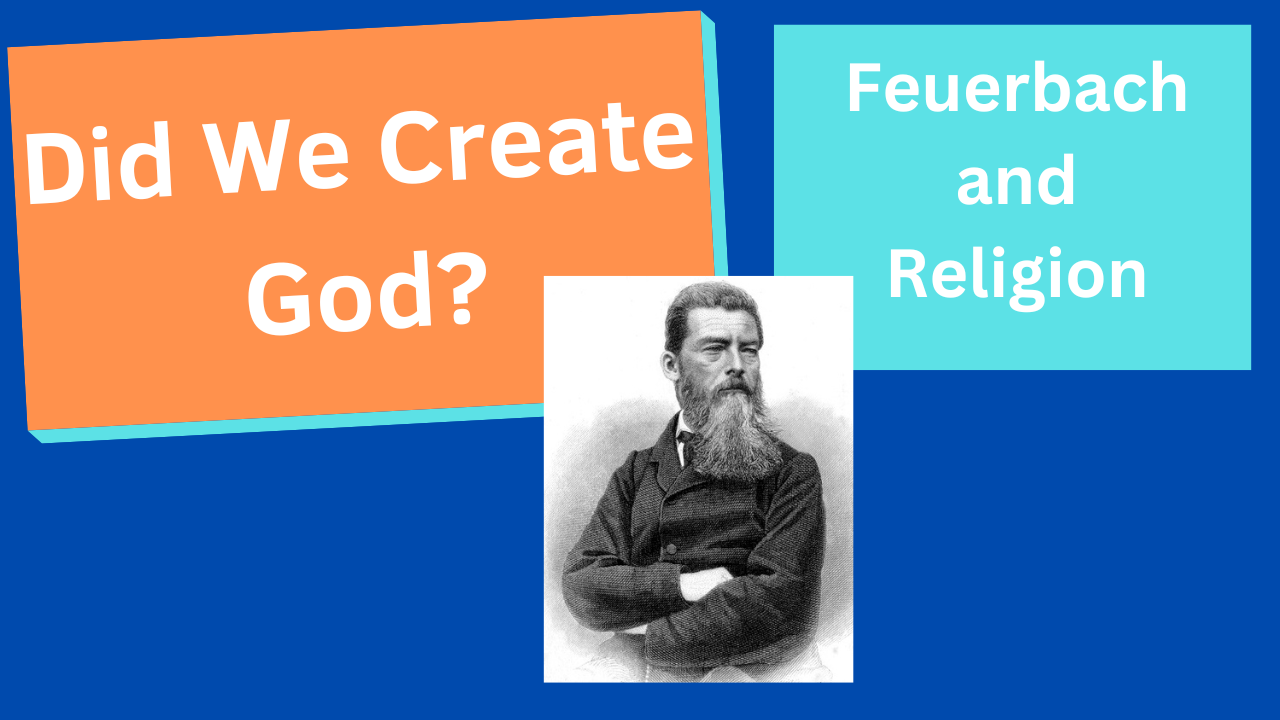02/19/2025 – Did We Create God? Feuerbach and Religion

Did we create God out of our own wishes and desires? Or was it out of our interaction with our natural environment? I am so stoked for this episode today. Stoked? Is that a word anyone even still uses? I’m such a boomer. Actually, Gen X’er, but who’s counting? Check this out. This is TenOnReligion.
Hey peeps, it’s Dr. B. with TenOnReligion. If you like religion and philosophy content one thing I really need you to do is to smash that sub button because it really helps out the channel. Also, if you find this content interesting drop me a Super Thanks here on YouTube. The transcript is available at TenOnReligion.com and new episodes are posted about every two weeks at noon, U.S. Pacific time, so drop me some views.
One of the earliest videos I ever created for this channel was on Feuerbach way back in 2020. My production quality was low back then but now I have a better way to present the ideas on this great religious philosopher along with some new material that you’re not going to want to miss. If you don’t know who Feuerbach is, you might want to hear this because it’s probably going to sound familiar. You just didn’t know it was this guy who actually started it. And by the end of this episode, you might just be a Feuerbach convert. Actually, I think I’m probably pretty close to being one myself. So, here’s the plan. Feuerbach has two theories. His early theory is the one most people know and the one for which he is famous. But he also reformulated, or refined if you will, his views, and so there’s also a later Feuerbach theory which you might like even better. So, we’re going to talk about both. Let’s get started.
Some background. Immanuel Kant was arguably the most important philosopher in German history and his major works came in the late 1700’s, right around the time the United States was forming as a modern nation-state. Kant initiated an entirely new way of philosophical thinking which became known as German Idealism: basically, objects cannot be known in themselves, but only as they appear to a perceiver. After Kant, Hegel arrived on the scene in the early 1800’s. More on him in a second. After Hegel, the German philosophical scene split into two camps known as Right and Left Hegelianism. The Right felt that Hegel’s philosophy reflected Christian orthodoxy and also felt that politically, European societies were the pinnacle of all civilizations. The Left Hegelians, often referred to as the Young Hegelians, were more liberal and interpreted Hegel’s philosophy as freeing humanity both religiously and politically. This was immediately apparent in Feuerbach’s contemporary, David Strauss, when he published The Life of Jesus Critically Examined in 1835. This was a shocking work for its time as he was the first one to call into question the historical reliability of the gospel accounts in the New Testament using newly developed concepts in the also now-birthing academic field of history in Europe. Then came Feuerbach.
Feuerbach’s early theory comes from his famous work titled, The Essence of Christianity first published in 1841, and his later theory comes from a later shorter work titled, The Essence of Religion published in 1846. One of best English-language works ever written about Feuerbach’s views was from the late Stanford University scholar Van Harvey, titled, Feuerbach and the Interpretation of Religion published in 1995. I read all of these books and we’re getting started with the early theory from The Essence of Christianity. Feuerbach’s entire early theory is a reworking of Hegel’s philosophy of religion which Feuerbach literally inverts completely. Later, Feuerbach heavily influenced three other thinkers – Karl Marx, Friedrich Nietzsche, and Sigmund Freud – but for some strange reason he does not often get the credit for that. Paul Ricoeur called these three thinkers the “masters of suspicion” because they all in some way thought that religion was a projection. But the idea of religion as a projection actually started with Feuerbach.
Now, back to Hegel for a quick minute or else none of this is going to make sense. For the first 30 years of the 1800’s Hegel’s philosophical and religious ideas were utterly dominant in Germany and most of Europe. His main focus was Geist, or Spirit, more specifically what he called the Absolute Spirit. The Absolute Spirit is a three-part dialectic of moments or sometimes called movements: Consciousness, Self-Consciousness, and Return; or Idea, Nature, and Spirit. Some of you may be familiar with the dialectic being described as thesis, antithesis, and synthesis, but that’s not Hegel. He actually never used those terms in his writings. That actually comes from an earlier German philosopher named Fichte. But Feuerbach’s big change, or inversion, of Hegel’s system is this. Remember your grammar class in school? Subject and object, or predicate. Humans are the subject and humans’ collective wishes and desires to be perfect is the object or predicate which becomes projected resulting in deity creation. Human beings come to full self-consciousness when they realize that God is their own objectified activity. Religious projection arises out of the nature of human self-consciousness itself. This means that consciousness of God is self-consciousness and knowledge of God is self-knowledge. Now this is a fascinating claim, so let’s unpack it a little more.
In the early 1840’s, Feuerbach’s book, The Essence of Christianity, exploded like a bomb on the German intellectual scene. Hegel said the Absolute Spirit, or God, achieves self-knowledge by objectifying or externalizing itself in the finite world and then completes itself by a return. Feuerbach reverses this. Religion does not go from infinite to finite, rather from finite to infinite. We, humans, created the idea of religious infinity. The basic premise is that superhuman deities of religion are simply projections of the essential aspects of human nature. For some, this seems outrageous. The idea of God or what is worshiped as divine is really just a synthesis of the human perfections. God is a reflection of us and not a metaphysical reality over and against us. This means theology is ultimately anthropology and the study of humans and the hidden meaning of Christianity is…atheism. Humanity creates the divine in its own image, collectively speaking. But how? You’re going to like this explanation.
The key is Feuerbach believed religion starts in the idea that the human species will endure even though individual human beings will die. The individual transforms the essential parts of consciousness like reason, will, and emotion into a transcendent, divine being and worships it. This is accomplished through the imagination which uses real world things which Feuerbach called the concrete. This is how divine representation and symbol creation starts. The empathy or love of humans for other humans become personified and projected into God. So, it’s like this: the imagination, under the pressure of feeling, ignores reality and seizes upon the concept of the human species and clothes it in the form of image, symbol, and myth all focused on securing the felicity, or happiness, of humanity. Feuerbach wants to convince everyone that it’s really human nature that is recognized and celebrated when humans create and worship deities, and through that process humans could come to estimate their own worth and dignity properly. You see, by placing all human perfections in a transcendent being through this projection process, the human species then deprives itself of these same perfections so this transcendent being can be worthy of worship. Our realities are therefore the realities of God. In us they exist with limits, but in God without limits. The personality of God is the personality of humans freed from all the conditions and limitations of nature. And, dudes and dudettes, this was just his early theory. Stick around if you want to hear more about his later theory.
Feuerbach’s later theory comes from The Essence of Religion in 1846 which became the basis for a series of 30 lectures in 1848 and 1849, and then after that a book, The Lectures on the Essence of Religion in 1851. In this later theory, religion has to do with the feeling of dependency upon nature and the way in which the encounter with nature gives rise to belief in spiritual beings or gods. In the early theory, the gods are generated out of human consciousness reflecting on itself, but in this later theory, the gods are generated by the impingement of external forces upon the self. In the human religious consciousness, these external powers of nature upon which humans are dependent, are differently conceived from culture to culture and era to era. Humans wish to be freed from the dependency upon nature and they posit a deity who transcends nature so it can master and control it, since humans can’t. Again, imagination and what Feuerbach calls the drive-to-happiness motivates this creation of deities. The differences among religions are, at least in part, differences in the materials upon which the imagination works. The natural environments in Germany are different from India, or Africa, or China and thus the created religious entities will likewise be different.
The scholar Van Harvey, mentioned earlier, refers to this second model as the naturalist-existentialist strand. In this model, the self longs to transcend this nature, specifically death, but it believes it can be saved only by a power that can transcend and intervene in nature and desires that this superhuman power be a personal subject. Thus, religion can best be described as a type of anthropomorphism rooted in the structure of self-consciousness; more precisely, in the two-fold differentiation of the self from nature, on the one hand, and the self from persons, on the other. This two-fold distinction creates the related desires to be free from nature and to gain recognition from other subjects. The gods satisfy both of these desires through miracles and personal communion or prayer. This later model also avoids the claim that there is a progression in religion and that Christianity represents the highest development, which was definitely a problem in Hegel’s philosophy that also partially carried over to Feuerbach’s early model.
Now a few quick thoughts on comparing the two theories. The motto of the early model is theology is anthropology vs. the motto of the later model, theology is anthropology plus physiology. In both models there is self-differentiation. But in the early model the projection is predicates of the human species – the idea of an essential and perfect human nature which then become God. In the later model the self seizes on some aspect of nature and personifies it by making it an “other” and thus a “subject” to be worshiped. In the early model, God is the objectification of human nature as freed from limitations. But in the later model, the gods are composite beings with some attributes from nature and others from human consciousness. It transforms the powers of nature into a subject concerned with human well-being.
Today we were talking about Feuerbach and his two theories of explaining religion. So, which is it? Do humans create deities out of their collective desires and wishes? Or are deities manufactured out of humans’ interaction with their environment? Or maybe there’s a middle road here by finding a way to create a new theory that incorporates aspects of both the early and later Feuerbach? Perhaps. Which theory did you find the most interesting and why? Leave a comment below and let me know what you think. And again, if this was in any way helpful, drop me a Super Thanks. Until next time, stay curious. If you enjoyed this, support the channel in the link below, please like and share this video and subscribe to this channel. This is TenOnReligion.


